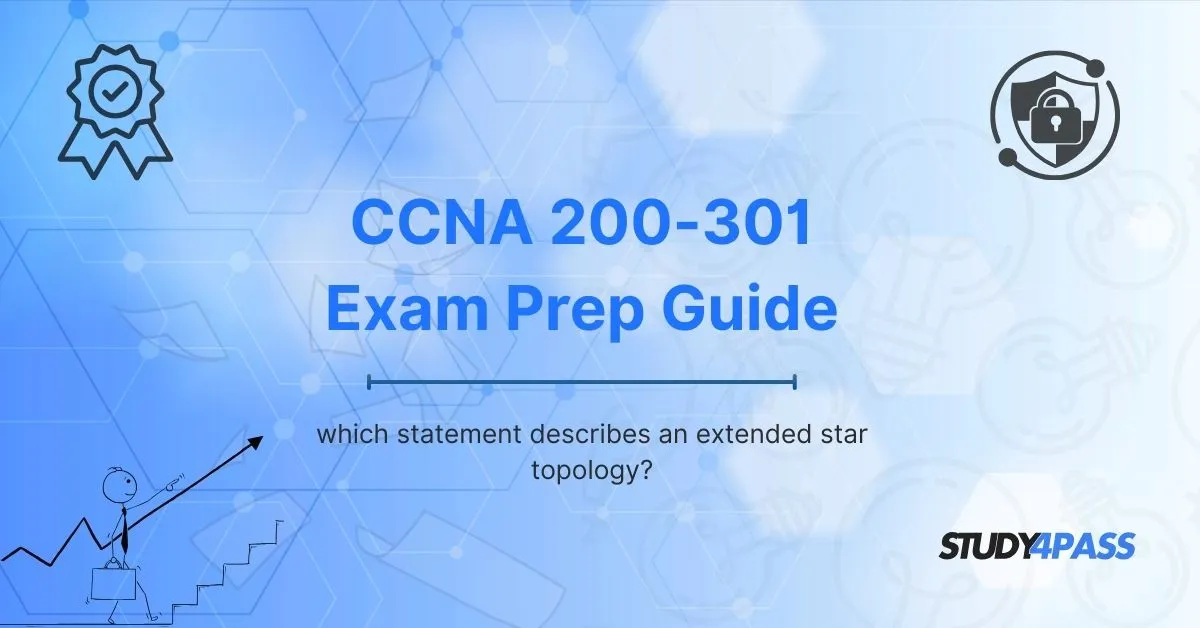Introduction To CCNA 200-301 Exam Prep Guide
Preparing for the CCNA 200-301 exam requires a solid understanding of network topologies, including the extended star topology. If you're using Study4Pass to guide your studies, you’ll need to master key concepts like this to pass the exam confidently.
In this CCNA 200-301 Exam Prep Guide, we’ll explore the extended star topology, its characteristics, advantages, disadvantages, and how it compares to other network topologies. By the end, you’ll be able to answer the question: Which statement describes an extended star topology? with ease.
What is a Network Topology?
Before diving into the extended star topology, let’s first define what a network topology is.
Definition: A network topology refers to the physical or logical arrangement of devices and connections in a network.
Types of Topologies:
- Star
- Bus
- Ring
- Mesh
- Hybrid
Extended Star
Understanding these topologies is crucial for the CCNA 200-301 exam, as Cisco tests your ability to recognize and implement them in real-world scenarios.
What is an Extended Star Topology?
Definition
An extended star topology is a variation of the standard star topology, where multiple star networks are interconnected through a central hub or switch.
- Key Feature: It consists of multiple layers of star networks connected hierarchically.
- Central Device: The core switch or hub acts as the main connection point for secondary switches or hubs.
- Scalability: Allows for easier expansion of networks by adding more star networks.
Visual Representation
- [Core Switch]
- [Switch A] [Switch B] [Switch C]
- [Devices] [Devices] [Devices]
Here, the core switch connects multiple secondary switches, each forming its own star network.
Which Statement Describes an Extended Star Topology?
When asked Which statement describes an extended star topology? in the CCNA 200-301 Exam, the correct answer would be something like:
An extended star topology consists of multiple star networks connected hierarchically through a central device, allowing for scalable and manageable network expansion.
Other possible descriptions include:
- A network where multiple star topologies are interconnected via a central hub or switch.
- A hierarchical star-based network design used in large-scale deployments.
Why is this important for the CCNA exam?
Cisco expects you to differentiate between topologies.
You may encounter simulation questions requiring you to identify or configure such networks.
Advantages of Extended Star Topology
Studying with Study4Pass ensures you grasp both theory and practical benefits. Here’s why extended star topology is useful:
1. Scalability
- Easily expandable by adding more switches or hubs.
- Ideal for growing businesses.
2. Fault Isolation
- If one branch fails, the rest of the network remains unaffected.
- Easier troubleshooting compared to bus or ring topologies.
3. Centralized Management
- Network admins can monitor and control traffic from the core switch.
- Simplifies security policies and updates.
4. High Performance
- Reduces collision domains (unlike bus topology).
- Efficient data routing with minimal latency.
5. Reliability
- Redundancy can be built by adding backup core switches.
Disadvantages of Extended Star Topology
While Study4Pass helps you focus on strengths, knowing weaknesses is equally crucial for the CCNA 200-301 exam.
1. Dependency on Central Device
- If the core switch fails, the entire network may go down.
- Requires high-quality, redundant hardware.
2. Higher Cost
- More cabling and switches increase deployment costs.
3. Complexity in Large Networks
- Managing multiple layers can become challenging.
4. Latency in Multi-tiered Networks
Data passing through multiple switches may experience delays.
Extended Star vs. Other Topologies
|
Topology |
Key Feature |
Pros |
Cons |
|
Extended Star |
Multiple star networks connected hierarchically |
Scalable, fault isolation |
Expensive, complex |
|
Star |
Single central hub with connected devices |
Simple, easy to manage |
Single point of failure |
|
Bus |
All devices share a single backbone cable |
Cheap, easy setup |
Poor scalability, collisions |
|
Ring |
Devices connected in a closed loop |
No collisions, predictable performance |
Failure disrupts entire network |
|
Mesh |
Every device connects to every other |
Highly reliable, redundant |
Expensive, complex cabling |
Understanding practical uses helps in the CCNA 200-301 exam and beyond.
1. Enterprise Networks
Large offices use extended star designs for departmental segmentation.
2. University Campuses
Different buildings (labs, libraries) connect via a central data center.
3. ISPs (Internet Service Providers)
Core routers connect regional hubs in a hierarchical manner.
4. Data Centers
Multiple server racks connect to a core switch for efficient traffic routing.
How to Configure an Extended Star Topology? (Lab Scenario)
Since the CCNA 200-301 Certification tests hands-on skills, here’s a basic lab idea:
Steps:
1. Set Up Core Switch (e.g., Cisco Catalyst 3560).
2. Connect Secondary Switches (e.g., Cisco 2960).
3. Attach End Devices (PCs, printers, servers).
4. Configure VLANs for segmentation.
5. Test Connectivity using `ping` and `traceroute
Conclusion
Mastering the concept of extended star topology is essential for anyone preparing for the CCNA 200-301 exam, especially with the help of trusted resources like Study4Pass. This topology combines the simplicity of a traditional star design with the scalability needed for modern networks, making it a common choice in enterprise environments, campuses, and data centers.
Special Discount: Offer Valid For Limited Time “Cisco 200-301 Exam Prep Practice Tests”
Actual exam question from Cisco's 200-301 Exam.
Sample Questions for Cisco 200-301 Exam Prep Practice Test
Which resource is the most effective for comprehensive CCNA 200-301 exam preparation?
A) Last-minute cramming using random online quizzes
B) A well-structured CCNA 200-301 exam prep guide with labs and practice tests
C) Memorizing answers from unverified exam prep practice test
D) Relying solely on YouTube videos without hands-on practice


